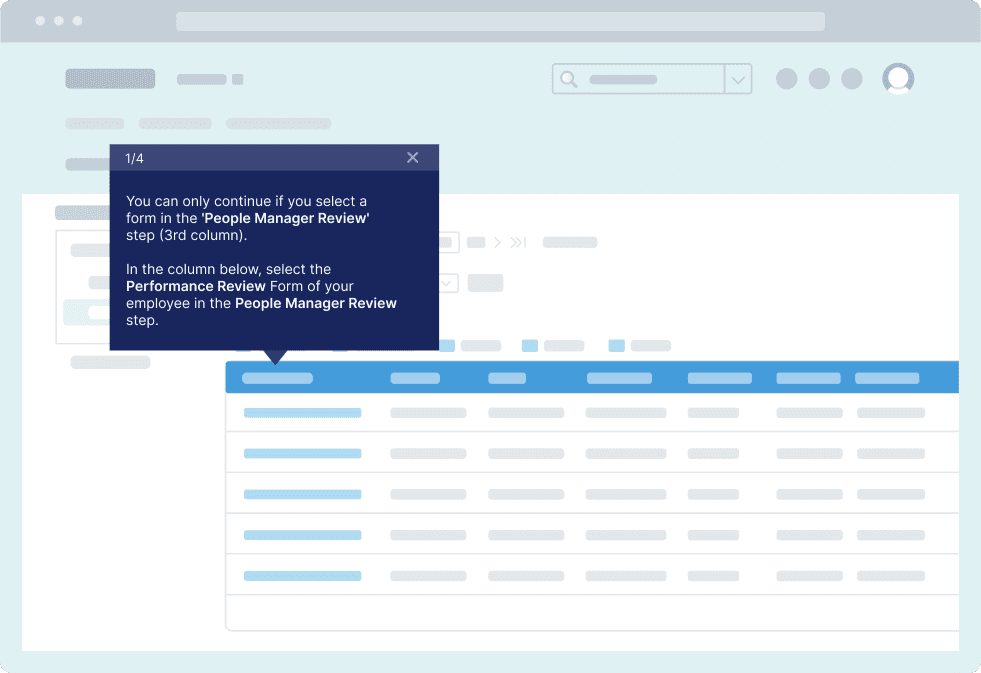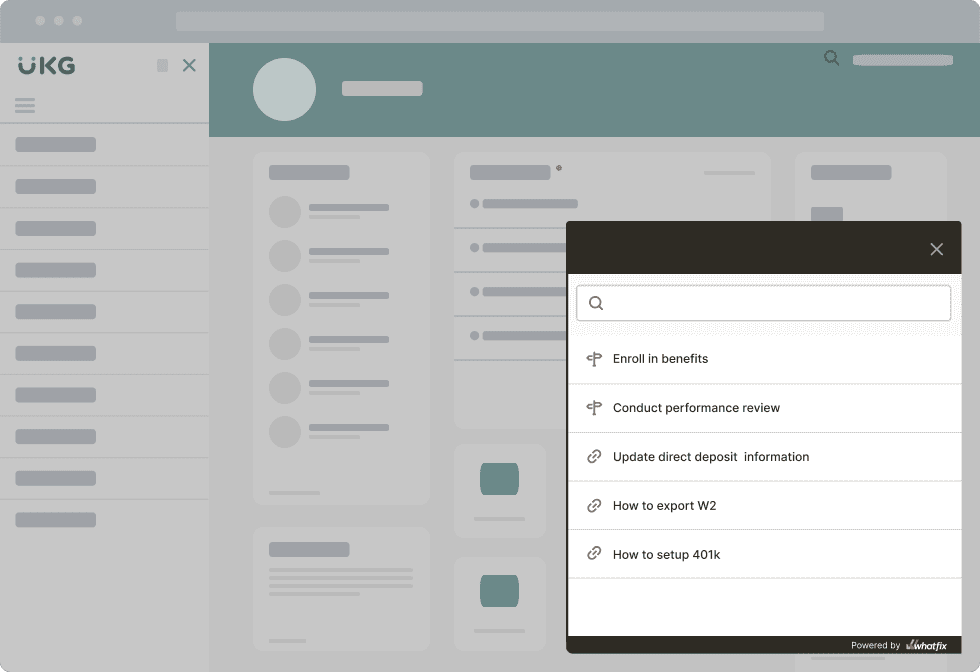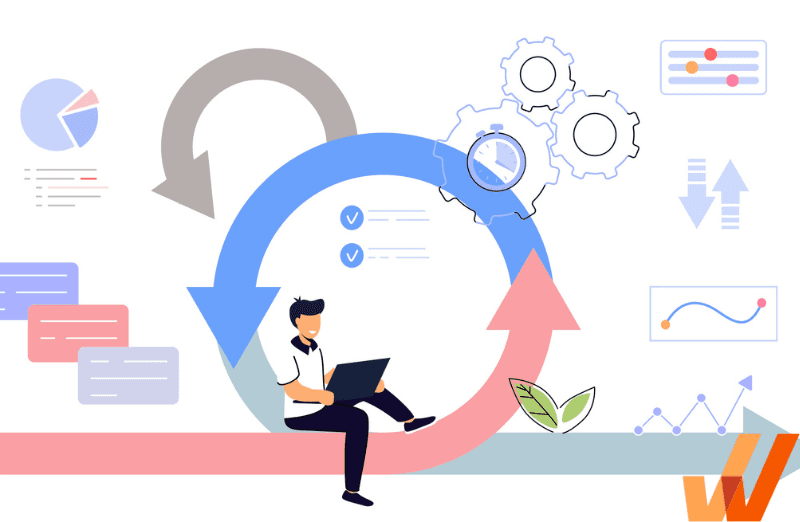To meet the needs of an evolving digital workforce, organizations must enable employees through transformative HR projects, applications, and frameworks. HCM systems are at the core of HR transformation.
In this article, we’ll discuss how enterprises are overhauling their workforce management with HCM systems, the benefits and challenges of undertaking a project of this scope, and how to drive HCM adoption with Whatfix.
What Is HCM Transformation?
Human Capital Management (HCM) transformation refers to the strategic overhaul of an organization’s approach to managing its workforce management. It involves reimagining and redesigning processes, technologies, and strategies for recruiting, hiring, training, developing, managing, and retaining employees. HCM transformation aims to enhance the efficiency, effectiveness, and agility of HR operations while also improving employee experience, engagement, and productivity.
This transformational journey often entails adopting advanced technologies such as cloud-based HCM software, data analytics, artificial intelligence, and automation to streamline HR processes, gain actionable insights, and drive informed decision-making.
8 Steps of an HCM Transformation Project
From initial assessment and planning to implementation, training, and continuous improvement, each step plays a pivotal role in shaping the success of the transformation. This section will explore these five key steps, providing insights and best practices for effectively navigating an HCM transformation.
1. Conduct a business needs assessment
This step involves thoroughly understanding the organization’s existing business processes, identifying pain points, and determining the specific needs and requirements the new HCM system should address.
To guarantee the success of your HCM transformation project from the outset, your initial objective should be to:
- Identify key stakeholders from various departments, including sales, marketing, customer service, and IT. These end-users will provide valuable insights into their respective areas of the business and help ensure that the HCM solution meets the needs of all departments.
- Work closely with stakeholders to gather requirements for the new HCM system. This may involve conducting interviews, surveys, and workshops to understand current workflows, pain points, and desired functionalities. Document all requirements in detail to serve as a foundation for selecting and implementing the HCM solution.
- Evaluate the organization’s data requirements for the HCM system, including the types of data to be captured, data sources, data integration needs, and data security considerations.
This step sets the stage for selecting the right HCM solution, designing tailored HR workflows, and implementing a system that meets the organization’s unique needs while driving measurable business value.
2. Identity HCM value drivers
Gartner defines value drivers as the, “factors that increase the worth of a product, service, asset or business.” In our context, HCM value drivers are the key features that’d make all the difference—the core capabilities you want out of your HCM transformation.
And speaking of features, there are so many capabilities HCM systems can be customized to offer or support, such as:
- Learning and development programs: Investing in training and development opportunities to enhance employee skills, knowledge, and career advancement, leading to improved performance and retention.
- Diversity, equity, and inclusion initiatives: Promoting diversity, equity, and inclusion (DEI) in the workplace.
- Employee well-being programs: Implementing wellness initiatives, work-life balance programs, and mental health support services to enhance employee health, morale, and overall well-being.
- HR process automation: Automating repetitive and time-consuming HR tasks such as payroll processing, benefits administration, and compliance reporting to improve efficiency and accuracy.
- Talent acquisition efficiency: Streamlining recruitment processes to attract top talent efficiently, reducing time-to-hire and cost-per-hire.
- Employee engagement enhancement: Implementing initiatives to foster a positive work environment, increase job satisfaction, and boost employee motivation and productivity.
Each of these value drivers are a theme or niche that you can focus your HCM transformation efforts on. That targeted approach will help narrow your efforts, keep your budget in check, and ensure your project is completed on schedule.
3. Assemble an HCM modernization and transformation team
This team will be handpicked from across your organization to oversee the entire transformation process, from planning and implementation to ongoing maintenance and optimization. The process for creating this team will vary slightly for each organization, depending on the company’s size and IT culture. Still, it will look like this:
- Forming a cross-functional team: Assemble a cross-functional team with diverse expertise and skill sets to progress the HCM modernization project. This team may include HR professionals, IT specialists, business analysts, change management experts, and external consultants or vendors with relevant experience. Ensure representation from all departments impacted by the transformation to foster collaboration and ownership.
- Establishing project sponsorship: Secure executive sponsorship and support for the HCM modernization project. Executive sponsors are critical in providing strategic direction, securing resources, and driving organizational buy-in for the transformation initiative. They also serve as champions for change and help overcome resistance to adoption.
- Defining roles and responsibilities: Clearly define roles and responsibilities for each team member based on their expertise and contributions to the project. Assign a project manager or team lead to oversee day-to-day activities, coordinate tasks, and track progress against milestones and deliverables. Establish communication protocols and reporting mechanisms to keep stakeholders informed and engaged throughout the project lifecycle.
- Setting clear goals and objectives: Define clear goals and objectives for the HCM modernization project, outlining the desired outcomes, timelines, and success criteria. Ensure that goals are SMART (Specific, Measurable, Achievable, Relevant, and Time-bound) to provide a clear roadmap for the team and measure progress effectively. Align goals with broader organizational objectives to demonstrate the value of the transformation initiative.
This team will play a critical role in driving organizational change, building momentum for adoption, and realizing the full potential of the HCM modernization initiative.
4. Implement a change strategy for your end-users
Within the HCM transformation context, your change management strategy is the structured approach your organization takes toward preparing for the switch to a new HCM platform (or significant changes to your current setup) so you can support and manage the stakeholders and end-users that depend on your HCM infrastructure during the transition.
First, your change management strategy needs to assess how ready your organization is for the switch, identifying potential barriers to change, such as resistance to technology adoption, fear of job loss, or lack of awareness about the benefits of the HCM system. Then, you need to communicate the vision for the HCM transformation and its benefits to employees and the organization, emphasizing how the new system will improve efficiency, streamline processes, and enhance the employee experience.
Also, you’ll need to identify and empower change champions and advocates within the organization to champion the HCM transformation and drive adoption among their peers. These champions can serve as role models, influencers, and mentors, sharing their experiences, best practices, and success stories to inspire others and build momentum for change.
5. Map and transfer (or recreate) all HR-related business processes
This is especially important if you’re porting to an entirely different HCM platform where you need to export all your data, workflows, and processes. As a result, you’ll have to document all your HR-related business processes, including recruitment, onboarding, performance management, training and development, compensation and benefits administration, employee relations, and offboarding.
Process mapping tools such as flowcharts, swimlane diagrams, or process narratives will help you visualize each step in the process and identify dependencies, inputs, outputs, and decision points.
6. Provide contextual end-user onboarding and training before and after implementation
Before the implementation, your end-user onboarding and training program needs to center on comprehensive training sessions tailored to different user personas (HR staff, managers, employees), focused on explaining the upcoming changes, including new processes, tools, and systems that will be introduced.
Once you’ve laid the groundwork, you must provide hands-on new system training using simulations or sandbox environments to familiarize users with the new HCM software and processes. Past that point, your training and development efforts need to switch to real-time, interactive resources offered via in-app guidance, videos, and job aids to supplement formal training sessions, as well as knowledge bases, docs, and guides users can reference at their own pace.
With a digital adoption platform (DAP) like Whatfix, enable your HCM end-users with role-based in-app guidance and real-time support through contextual HCM tours, interactive walkthroughs, tooltips, self-help resource centers, and more. Identify areas of end-user friction with behavioral analytics and overcome these trouble areas with additional in-app assistance.

7. Enable HCM end-users with post-implementation support
Post-implementation support offers your end-users an ecosystem of assistance and guidance resources to help them figure out how your HCM infrastructure works after changes are made. Among others, you’ll need to:
- Adopt/develop comprehensive training programs: If your HCM platform of choice has a dedicated end-user training program (e.g., Oracle University, SAP SuccessFactors Learning Academy, Ceridian Dayforce Learning), you can adopt theirs or create a program designed to teach your end-users how key features and functionalities of the HCM system work, as well as best practices for using it effectively in daily tasks. Offer a variety of training formats, including in-person workshops, online tutorials, user manuals, and self-paced learning modules.
- Create user guides and documentation: Develop user-friendly guides, manuals, and documentation that provide step-by-step instructions for common tasks and processes within the HCM system. Make these resources easily accessible through the company intranet or HCM portal so that users can refer to them whenever needed.
- Establish a dedicated support channel: Set up a dedicated support channel, such as a helpdesk or service desk, where end-users can submit inquiries, report issues, and seek assistance with HCM-related issues. Ensure that there are knowledgeable support staff available to respond to queries promptly and provide timely resolutions to any issues encountered.
- Facilitate peer-to-peer learning and knowledge sharing: Foster a culture of peer-to-peer learning and knowledge sharing among end-users by facilitating user forums, discussion groups, and community platforms where employees can share tips, best practices, and insights related to the HCM system. Encourage experienced users to mentor and support their colleagues in adopting and maximizing the use of the HCM platform.
Most often, your HCM of choice will have a large library of helpful resources designed to help you succeed with their product. You can build on those resources, customize them to suit your use cases, and even hire implementation experts to spearhead your post-implementation support program to ensure your HCM platform and its new features don’t become yet another piece of expensive shelfware no one uses.

8. Analyze HCM end-user behavior and address friction areas
Enterprises tend to miss the forest for the trees during their digital transformation efforts and often fail to ask, “so, how has our human capital management performance improved (or worsened) since our HCM transformation efforts began?”
If care isn’t taken to assess the outcomes of your HCM transformation, it’ll become yet another vanity project, investing in new, improved technology for its own sake.
Instead, since HCM systems are designed to improve HR experiences for end-users (i.e., both HR specialists and employees) who interact with them, you can measure how your HCM setup has influenced their interactions using user behavior analytics. Here’s a step-by-step process that can help you:
- Define key metrics: Start by defining key metrics to measure end-user behavior and engagement within the HCM system. These metrics may include user logins, frequency of use, time spent on specific tasks, completion rates for training modules, and feedback gathered from end-users.
- Gather data: Collect data on end-user behavior through various sources, including user activity logs, system analytics, surveys, and focus groups.
- Map user journeys: Map out the typical user journeys within the HCM system, from onboarding and day-to-day tasks to performance reviews and learning activities. Identify touchpoints where end-users may encounter friction or challenges in navigating the system or completing tasks.
- Identify friction areas: Analyze the data collected to identify friction areas or pain points experienced by end-users. These may include usability issues, confusing interfaces, lack of training or support, slow system performance, or gaps in functionality that hinder productivity or engagement.
- Seek feedback: Gather feedback directly from end-users through surveys, interviews, or focus groups to understand their perspectives and experiences with the HCM system.
Ultimately, your end users won’t keep using a platform they consider unintuitive or unsuited to their needs. Keeping tabs on user behavior signals helps you understand how you can smoothen out rough edges in your HCM platform’s user interface to make it a more effective tool in your human capital management setup.
Benefits of HCM Transformation
Gallup estimates that it can cost up to 2x an employee’s annual salary to replace them when they quit. Assuming a median salary of $59,428 per year (according to the Bureau of Labor Statistics), it costs up to $118,856 to hire a replacement for a single worker. It doesn’t look good when you factor that figure into your company’s average turnover rate. And that’s why employee engagement and the HCM platforms that make it possible matter.
Beyond the direct impact of HCM transformation on your workforce, properly deploying the best-fit HCM platform will help your organization better plan your HR decisions with data, streamline your processes to save time, and reduce cost by eliminating repetitive manual tasks.
1. Improved workforce productivity
Traditional HR processes often involve manual paperwork, which can be time-consuming and error-prone for both HR specialists and the employees on the receiving end.
For instance, recruitment processes typically involve manual job postings, resume screening, and scheduling interviews; time tracking and attendance often have to be checked off by hand; administering employee benefits such as healthcare, retirement plans, and other perks involve manual enrollment, eligibility verification, and handling of paperwork related to claims and changes in coverage.
In contrast, modern, tech-enabled HCM systems (i.e., both tools and workflows) replaces these manual processes with automated systems, such as self-service portals for tasks like time-off requests, benefits enrollment, and performance reviews. By streamlining administrative tasks, employees and HR personnel can focus more on value-adding activities, thus improving productivity.
2. Enhanced employee engagement and satisfaction
Integrated HCM systems enable organizations to personalize employee communication through targeted messages, notifications, and feedback mechanisms. Similarly, they can facilitate the implementation of recognition and rewards programs (think performance tracking, peer recognition, and milestone celebrations) to acknowledge employees’ contributions and achievements.
By tailoring communication to individual preferences and needs, organizations can foster a sense of belonging and engagement among employees, enhancing their overall satisfaction with the workplace.
3. Data-driven decision-making
Since your HCM platform functions as a second brain for all your HR operations, it doubles as a single source of truth for the insights required to inform strategic initiatives, improve workforce management, and drive business outcomes.
For instance, real-time analytics and reporting will enable your HR managers to access up-to-date information on key HR metrics, such as turnover rates, employee engagement scores, and workforce demographics. In contrast, predictive analytics will assist the C-suite in forecasting future workforce trends by analyzing historical data on employee turnover, performance, and engagement.
Likewise, that data-first approach translates better scenario planning, benchmarking, and comparison to ensure you can keep attracting (and retaining) top-tier candidates with reasonable compensation and benefits.
4. Better talent acquisition and retention
By using applicant tracking systems (ATS) and AI-powered recruitment tools, modern HCM products enable enterprises to identify qualified candidates more efficiently, reduce time-to-hire, and improve the overall candidate experience.
Even during the hiring phase, it enhances the candidate experience through user-friendly career portals, personalized communication, and transparent feedback mechanisms that leave a great impression and make it easier to win over A-class employees.
Most importantly, data is at the core of modern HCM operations, and a digital transformation will give you access to comprehensive workforce data and analytics, enabling data-driven decision-making in talent acquisition.
By analyzing recruitment metrics, such as source effectiveness, time-to-fill, and candidate quality, your organization can optimize recruitment strategies, allocate resources effectively, and identify areas for improvement.
5. Streamlined HR processes
The proper human capital management platform will serve as a hub for all your HR processes that’ll enable your organization to quickly:
- Centralize employee data, including personal information, employment history, performance evaluations, and training records, into a single, unified system
- Standardize HR processes and workflows across departments and locations, ensuring consistency and compliance with internal policies and regulatory requirements.
- Automate repetitive HR tasks such as payroll processing, benefits administration, and compliance reporting, reducing the need for manual intervention and streamlining operations.
- Empower employees to manage their HR-related tasks, such as updating personal information, accessing pay stubs, and requesting time off, without HR intervention.
By leveraging integrated HCM systems and automation technologies, organizations can streamline HR operations, reduce administrative burden, and focus on strategic initiatives to drive business growth and success.
6. Cost savings through automation
SHRM suggests that the ideal HR department size ranges between 1.5 to 4.5 staff per 100 employees. But, if you’re operating at enterprise scale, that’s up to 2,250 for a workplace with, say, 50k employees. Modern HCM platforms are designed to automate the bulk of the HR process and largely reduce human input to approvals and reviews. This allows enterprises to optimize resources, reduce operational expenses, and increase efficiency by:
- Eliminating paper-based processes: HCM transformation replaces paper-based HR processes with digital workflows, eliminating costs associated with printing, storing, and managing physical documents. Organizations can reduce paper waste and related expenses by digitizing processes such as performance reviews, time tracking, and leave management while improving accessibility and compliance.
- Consolidating HR service vendors: Integrating multiple HR systems into a single HCM platform allows organizations to consolidate vendors and reduce licensing, maintenance, and support costs associated with managing multiple systems. Organizations can achieve economies of scale, negotiate better pricing terms, and reduce overall IT expenditure by standardizing on a single platform.
- Reducing labor costs: Automating repetitive tasks frees up HR professionals from manual data entry and administrative work, allowing them to focus on higher-value activities such as talent acquisition, employee engagement, and strategic workforce planning. This reduces labor costs associated with manual processes and increases overall efficiency.
7. Increased compliance and reduced risks
Instead of trying to keep tabs on regulatory and compliance tasks you need to fulfill as part of your human capital management workflow, the right HCM platform can help you put those tasks on autopilot with a combination of:
- Standardized processes: Automating routine compliance tasks such as policy acknowledgments, training assignments, and audit preparations reduces the risk of errors and omissions that may lead to non-compliance penalties.
- Auditing and monitoring capabilities: This enables organizations to track changes to employee payroll records, monitor access permissions, and detect potential compliance violations more effectively.
- Enhanced data security: Data encryption, access controls, and user authentication mechanisms ensure compliance with data protection regulations and protect your organization’s reputation in an increasingly complex and regulated business environment.
- Streamlined reporting: Generate comprehensive compliance reports, track key metrics, and identify areas of non-compliance more efficiently.
8. Agility in responding to market changes
Modern HCM systems allow organizations to efficiently adapt their workforce operations to changes in the market, such as remote work, flexible scheduling, and contingent labor. By offering HCM leaders real-time visibility into their workforce’s availability and skills, organizations can quickly scale their workforce up or down in response to fluctuating market demands.
9. Scalability for business growth
Whether you depend on full-time employees, contractors, or contingent hires, a consolidated HCM platform will enable your organization to streamline talent acquisition and quickly identify, recruit, and onboard top talent.
Better still, you can maintain a database of potential hires, track their availability to anticipate your talent needs, and proactively recruit candidates with the right skills to meet evolving requirements as your business scales.
10. Enhanced organizational competitiveness
Your HCM setup can help you automate administrative tasks such as payroll processing, benefits administration, and compliance management, reducing manual workload and minimizing errors. By optimizing HR processes and workflows, your organization can achieve significant cost savings, improve productivity, and reallocate resources to strategic initiatives that drive competitive advantage.
Challenges in the HCM Transformation Process
From integrating disparate software solutions to fostering employee adoption and optimizing workflows, the journey toward realizing the full potential of HCM is riddled with complexities. In this section, we will examine the challenges you’ll encounter throughout the HCM transformation process and explore how innovative solutions, such as Whatfix’s digital adoption platform, can facilitate your transition, empowering your organization to unlock the true value of your HCM investments.
1. HCM integration
HCM platforms don’t exist in a vacuum. They must be integrated with the rest of your software stack, including payroll, benefits administration, time tracking, and talent management systems. These systems may not be inherently compatible with each other (especially if they’re custom-built tools without mainstream APIs), leading to difficulties in integrating them seamlessly with the HCM system.
Likewise, if you have legacy software applications in your stack, they lack modern APIs or may be incompatible with newer cloud-based HCM solutions. Integrating these systems with HCM platforms can be particularly challenging due to their outdated technology stack.
And since integrating HCM systems involves sharing sensitive employee data across different platforms, ensuring data security and compliance with regulations such as GDPR or HIPAA is paramount. This requirement creates overhead since you must implement robust security measures and adhere to strict compliance standards throughout the integration process.
2. HCM and people-related data migration
Legacy HCM systems often have inherent limitations, including outdated technology, incompatible data formats, or rigid architectures. You might have to manually align data structures and formats between old and new systems, map data fields, ensure compatibility, and integrate data from disparate sources.
Finally, your digital transformation efforts still need to account for protecting sensitive employee data while you’re making the switch, and depending on where your business operates, you’ll have to deal with regulations such as GDPR, CCPA, or a combination of several at once.
3. Change management and communication
Change management is indispensable in the HCM transformation process. It offers your organization’s teams and departments a workable blueprint for navigating the transition, helps IT leaders manage stakeholder expectations, and ensures a smooth transition to new systems.
But, along the way, you’ll have to counter resistance to change, align your transition strategy with your organization’s internal culture, and make sure each stakeholder has the training and learning resources they’ll need to explore your new HCM confidently.
For example, transitioning from a traditional performance management system to a modern, continuous feedback system like Reflektive or Lattice may encounter resistance from employees accustomed to annual reviews, and failing to communicate the timeline and objectives for making the switch will confuse your stakeholders while the process progresses.
4. HCM end-user adoption
Employees may not fully understand the purpose and benefits of the new HCM system, leading to reluctance or resistance to use it. And when they agree to make the switch, if the new platform’s user interface deviates significantly from the patterns they’re used to, they might be frustrated and revert to their old workflows.
To avoid these pitfalls, you need to:
- Develop comprehensive training programs tailored to user groups, including HR professionals, managers, and employees.
- Offer a variety of training formats, such as instructor-led sessions, online tutorials, and self-paced learning modules, to accommodate different learning preferences and schedules.
- Establish a dedicated support desk or help center staffed with knowledgeable personnel to promptly address users’ questions and issues.
- Proactively address resistance to change by involving employees in decision-making and soliciting feedback and suggestions.
- Highlight the benefits of the new HCM system, such as improved efficiency, transparency, and access to information.
- Recognize and reward early adopters to incentivize others to follow suit and foster a culture of continuous learning and improvement.
By addressing these challenges and implementing targeted strategies to promote HCM end-user adoption, organizations can maximize the value of their investment in the system and drive positive outcomes for both employees and the business.
5. Continuous HCM training and end-user support
After the initial rollout, you need an ongoing training and development regiment to keep your end-users engaged, test their skill level periodically, and ensure they adapt your new HCM’s features to their roles’ use cases. After all, without regular reinforcement and practice, employees may forget how to use certain features or overlook new functionalities introduced in system updates. This can lead to underutilization of the HCM system and missed opportunities for process improvement.
Employee turnover and new hires also present challenges for maintaining consistent levels of HCM proficiency across the organization. New employees may require comprehensive onboarding to familiarize themselves with the HCM system and its functionalities.
Your employees will also encounter technical issues or have questions about using the HCM system during their day-to-day activities. Limited access to timely support resources can hinder their ability to resolve issues quickly and efficiently.
6. Budgeting and resource allocation
On average, the cost of HCM transformation at an enterprise can range from $100k to as high as $27.5 million, as is standard for mainstream digital transformation efforts. For the most part, the figures scale with the size of the company and cover software licensing, implementation services, data migration, training, and ongoing support.
Getting the C-suite’s buy-in is also critical, especially after you’re deep into your implementation. For instance, if your HCM transformation project’s sponsors start raising concerns about budget overruns, the entire project can be shut down, even if you’re 90% of the way through.
7. Analyzing and improving HCM workflows
HCM workflows often involve multiple steps and stakeholders, leading to complexity and inefficiency. For example, the employee onboarding process may require input from HR, IT, and departmental managers, resulting in delays and bottlenecks.
Similarly, inadequate visibility into HCM workflows can impede decision-making and hinder accountability. At the same time, employees may resist changes to existing HCM workflows due to fear of the unknown or concerns about job security. Resistance to change can hinder the adoption of new workflows and impede efforts to drive process improvements.
Enable HCM Transformation with Whatfix’s digital adoption platform
Whether you’re switching from a legacy HCM package or an existing mainstream option or making changes to an existing setup, a digital adoption platform will help you coach your end-users through your HCM of choice so they can use it confidently and run through workflows faster and more efficiently. That’s where Whatfix comes in: our DAP suite is designed to enable enterprises to streamline the adoption process with tailored features such as:
- Interactive Walkthroughs: Guide employees through complex HCM processes step-by-step.
- Contextual Tooltips: Provide relevant information and tips within the HCM platform interface.
- Self-Help Menus: Offer easy access to FAQs, tutorials, and knowledge base articles.
- Task Lists: Break down complex tasks into manageable steps for employees.
- In-App Announcements: Communicate updates and changes directly within the HCM platform.
- Performance Analytics: Track user engagement and identify areas for improvement.
- Personalized Recommendations: Suggest relevant resources based on user behavior and preferences.
- Multilingual Support: Localize UI text, prompts, and alerts into 70+ languages.
- Compliance Training: Deliver mandatory compliance training modules seamlessly within the HCM platform.

HCM clicks with Whatfix
Whatfix’s digital adoption platform offers a comprehensive solution to enable HCM transformation by providing on-demand support, enhancing user adoption, streamlining training and onboarding, and improving workflow efficiency. With Whatfix as a trusted partner, organizations can confidently navigate the complexities of HCM transformation and achieve their desired outcomes efficiently.
Dive deeper with more HR & people management and digital transformation content.
Are you looking to become a more data-driven product manager? Explore our product analytic-centric content now.













